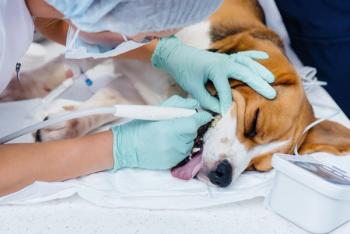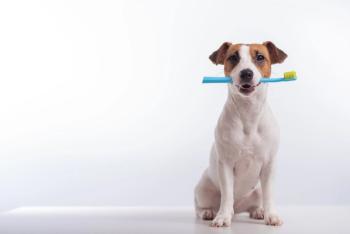
ACVC 2019: Considerations in oral neoplasia surgery
Mandibulectomy and maxillectomy are relatively common surgical options for oral neoplasia resection in veterinary patients. For optimal success, keep these points in mind.
Sebestyen/stock.adobe.com[FLESH OUT THE INTRO NEEDS BASED ON SESSION] [delete this line before publishing]
At the 2019 Atlantic City Veterinary Conference, Mark M. Smith, VDM, DACVS, AVDC, walked participants through three surgical procedures commonly used to treat oral neoplasia in dogs and cats, and provided several considerations for undertaking each.
Rostral Mandibulectomy
Unilateral or bilateral mandibulectomy is indicated to remove neoplasms of the rostral mandible, nonunion, or chronic osteomyelitis, said Dr. Smith, a partner at the Center for Veterinary Dentistry and Oral Surgery in Gaithersburg, Maryland. It can be used for both benign and malignant tumors, and most veterinary patients look normal within a month or less.
Be sure to consider these points:
Performing a pharyngostomy for endotracheal tube placement facilitates extensive oral surgery.
Bone wax is a foreign substance and may disrupt wound healing. Its use is not necessary for hemostasis at mandibulectomy sites or for stabilizing the mandibular body following resection.
Full-thickness lip excision may be required to restore acceptable cosmesis. Resecting a triangular section with the base of the triangle along the mucocutaneous junction shortens the lip, which must be sutured to oral mucosa.
Wound dehiscence may occur over the resected mandible. It typically heals by second intention with conservative management.
No solid food should be given during the first week after surgery.
Tongue protrusion may occur following surgery, but patients usually adapt to keep the tongue retracted into the oral cavity. Cheiloplasty may be required to shorten the lip commissure and prevent tongue protrusion. Owners rarely complain about cosmesis following this procedure.
Lateral Premaxillectomy
This procedure is used for neoplasia removal and oronasal fistula reconstruction. Be sure to consider these points:
Maxillectomy may be performed either with an oscillating bone saw or with an osteotome and mallet after scoring the osteotomy lines with small, perforating holes.
Nasal turbinectomy should be performed in cases in which the neoplasm invades the nasal cavity.
Premaxillectomy and partial maxillectomy are limited by the surgeon's ability to reconstruct the oronasal defect. Patients with lesions that cross midline are usually not good candidates for partial maxillectomy.
Tension-free closure is imperative to avoid wound dehiscence and subsequent oronasal fistula. Failure of second-intention healing for partial wound dehiscence necessitates oronasal fistula repair.
No solid food should be given during the first week after surgery.
Postsurgical cosmesis is generally good. Facial concavity and an elevated lip may occur but do not affect function and are usually accepted by the owner.
Rostral Maxillectomy
This procedure is indicated for neoplasia resection. Be sure to consider these points:
When performed caudal to the level of the maxillary first premolar, this procedure results in shortening of the nose.
Wound dehiscence is uncommon and usually heals by second intention. Some patients require a second, minor revision surgery.
No solid food should be given during the first week after surgery.
Nasolacrimal duct transection or ligation may lead to intermittent serous discharge resulting in crusting of the nares and epiphora. No effort is made to ligate the nasolacrimal duct.
Cosmesis following surgery is generally good. Drooping of the nose ventrally and displacement of the maxillary lip caudal to the mandibular canine teeth may occur but do not affect function and are usually accepted by the owner.
Newsletter
From exam room tips to practice management insights, get trusted veterinary news delivered straight to your inbox—subscribe to dvm360.



